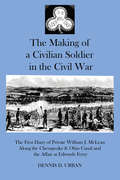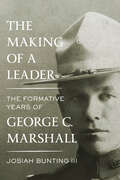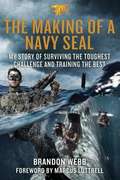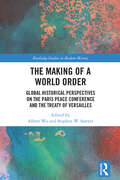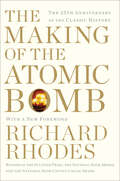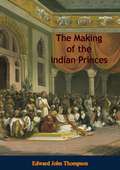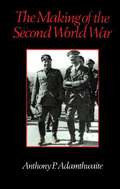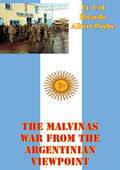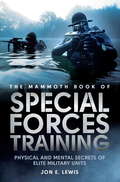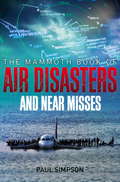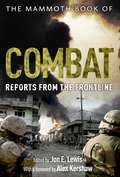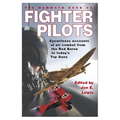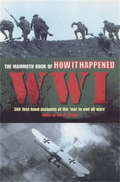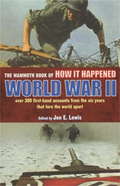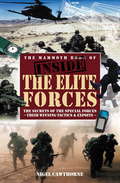- Table View
- List View
The Making of a Civilian Soldier in the Civil War: The First Diary of Private WIlliam J. McLean Along the Chesapeake & Ohio Canal and the Affair of Edwards Ferry
by Dennis D. UrbanThis Union soldier&’s diary recounts his journey from enlistment to postwar life, with extensive historical and biographical context provided by the editor. When war broke out between the states, William J. McLean left his home in Fairfield, NY, and joined the 34th New York Infantry. He kept a diary that tells of his many wanderings and adventures, from his time in Washington, D.C. to picket duty along the Chesapeake and Ohio Canal. William also describes the first death of a soldier in his regiment, the excitement over Bull Run, and an incursion into rebel-infested Virginia. Offering much more than a simple diary transcription, editor Dennis D. Urban sheds light on the actions of the 34th at Edward&’s Ferry during the Battle of Balls Bluff; McLean&’s effort to correct his military and pension records; and the post-war years of William, his brother, and his father, all of whom served the Union cause. Extensive chapter notes also provide biographical information about the regimental friends and other individuals William mentions in his entries.
The Making of a Leader: The Formative Years of George C. Marshall
by Josiah BuntingA portrait of one of the greatest leaders of modern history, George Catlett Marshall (1880–1959), and a distillation of the essential lessons his formative years offer to the leaders of today and tomorrowGeorge Marshall&’s accomplishments are well known: after helping to guide the Allies to victory during World War II, he set Europe on the postwar path to recovery with the plan that bears his name and was awarded the Nobel Peace Prize in 1953. But how did he become such an effective leader?By eschewing the years and accomplishments for which Marshall is most often remembered and focusing instead on the decisive moments that preceded them, The Making of a Leader provides the most detailed look yet at the mettle of Marshall&’s character, from his arrival as a cadet at the Virginia Military Institute and his Fort Leavenworth days—where he &“learned how to learn&”—to his instructive time as John J. Pershing&’s aide-de-camp and his critical experiences during World War I. Josiah Bunting III, a lifelong educator and former superintendent of Marshall&’s alma mater, highlights the importance of Marshall&’s activity between the wars, when he led &“the single most influential period of military education&” at Fort Benning, eventually culminating in his appointment as Army Chief of Staff in 1939.In this illuminating portrait, Bunting cuts through the legend of Marshall to the man—his frustrations, passions, loves, and brilliance—revealing a humble commander who knew not only how to lead but how to see the leader in others.
The Making of a Navy Seal: My Story of Surviving the Toughest Challenge and Training the Best
by John David Mann Brandon WebbBorn Ready for Action Boot Camp Training Becoming a Navy SEAL One of America's Deadliest Snipers Duty Calls Continuing to Protect and Defend
The Making of a World Order: Global Historical Perspectives on the Paris Peace Conference and the Treaty of Versailles (Routledge Studies in Modern History)
by Stephen W. Sawyer Albert WuWhy does 1919 deserve further study and debate a hundred years later? What lessons for global history may we learn from the world order created at the end of the Great War? Drawing insight from the global turn of the past several decades that has forced us to reconsider the most important world events and processes since the French Revolution and especially the growing interest in World War I as a global conflict that extended far beyond the borders of Europe, this volume explores the global political ramifications of the treaties prepared at the Paris Peace Conference in 1919 by focusing on key topics: how the Paris Peace Conference re-shaped the geo-political configurations of the Middle East, the importance of transformations in Asia and particularly China in the immediate postwar period, the shifts in Southeastern Europe, new feminist movements in Central Europe, and the pre-history of neoliberalism. Read together, the papers demonstrate how the peace treaties signed in 1919 and 1920 marked a profound transformation on local, national, continental, and global scales.
The Making of the Atomic Bomb: 25th Anniversary Edition
by Richard Rhodes**Winner of the Pulitzer Prize, the National Book Award, and the National Book Critics Circle Award** The definitive history of nuclear weapons—from the turn-of-the-century discovery of nuclear energy to J. Robert Oppenheimer and the Manhattan Project—this epic work details the science, the people, and the sociopolitical realities that led to the development of the atomic bomb.This sweeping account begins in the 19th century, with the discovery of nuclear fission, and continues to World War Two and the Americans’ race to beat Hitler’s Nazis. That competition launched the Manhattan Project and the nearly overnight construction of a vast military-industrial complex that culminated in the fateful dropping of the first bombs on Hiroshima and Nagasaki.Reading like a character-driven suspense novel, the book introduces the players in this saga of physics, politics, and human psychology—from FDR and Einstein to the visionary scientists who pioneered quantum theory and the application of thermonuclear fission, including Planck, Szilard, Bohr, Oppenheimer, Fermi, Teller, Meitner, von Neumann, and Lawrence. From nuclear power’s earliest foreshadowing in the work of H.G. Wells to the bright glare of Trinity at Alamogordo and the arms race of the Cold War, this dread invention forever changed the course of human history, and The Making of The Atomic Bomb provides a panoramic backdrop for that story. Richard Rhodes’s ability to craft compelling biographical portraits is matched only by his rigorous scholarship. Told in rich human, political, and scientific detail that any reader can follow, The Making of the Atomic Bomb is a thought-provoking and masterful work.
The Making of the Indian Princes
by Edward John ThompsonIndia’s political framework was made in twenty years: in 1799-1819, between the death of Tipu Sultan and the elimination of the Peshwa. The period opens with the destruction of the Muslim kingdom of Mysore and ends with the disintegration of the Maratha Confederacy into a series of separate chieftaincies. These two conquests gave the British the control of India.After Tipu’s destruction the Marathas remained. When they were finally beaten down, Modern India was formed and its map in essentials drawn. The arrangement was to stay until the slow process of time and the coming of new systems of political thinking made it an anachronism, calling for Round Table Conferences, White Papers, and their sequel in constitutional legislation and political offers. India, as we knew it yesterday and the world has known it, was made in the space of these twenty years, first by the shattering of what Lord Wellesley styled ‘the Mahratta Empire’ and then, after a brief period of uncertain and faltering doctrine, by Lord Hastings’ firm establishment of the States which had survived, each in the niche and status which was to be legally accepted as its own until our day. The Indian ‘Prince’ emerged in 1806, arising, like the Puranic Urvasi, from the churning of the Ocean by the Gods and Demons, and received his position in India’s polity in 1819.
The Making of the Modern Admiralty: British Naval Policy-Making 1805-1927
by C. I. HamiltonThis is an important new history of decision-making and policy-making in the British Admiralty from Trafalgar to the aftermath of Jutland. C. I. Hamilton explores the role of technological change, the global balance of power and, in particular, of finance and the First World War in shaping decision-making and organisational development within the Admiralty. He shows that decision-making was found not so much in the hands of the Board but at first largely in the hands of individuals, then groups or committees, and finally certain permanent bureaucracies. The latter bodies, such as the Naval Staff, were crucial to the development of policy-making as was the civil service Secretariat under the Permanent Secretary. By the 1920s the Admiralty had become not just a proper policy-making organisation, but for the first time a thoroughly civil-military one.
The Making of the Second World War
by Anthony P. Adamthwaite"The Reformation, the French Revolution, the First World War were episodes so explosive and cataclysmic that the discussion of their origins exercises a perennial fascination. The Second World War is in a similar category. There are several reasons for the attraction it exerts: fashionable nostalgia; the background of intense ideological struggle between fascism, communism and democracy; the decisive contribution of the war to the decline of western Europe from the political pre-eminence enjoyed for four hundred years; the mass of public and private papers - never before have historians been able to write so close to events with the benefit of archives; lastly the fact that it was a peoples’ war, involving all the machinery and resources of the modern state." -Introduction: Sources and Historiography
The Malayan Emergency & Indonesian Confrontation: The Commonwealth's Wars, 1948–1966
by Robert JacksonThe struggle with Communist terrorists in Malaya known as The Emergency became a textbook example of how to fight a guerrilla war, based on political as much as military means. This book deals with both the campaign fought by British, Commonwealth and other security forces in Malaya against Communist insurgents, between 1948 and 1960, and also the security action in North Borneo during the period of Confrontation with Indonesia from 1962 to 1966. Both campaigns provided invaluable experience in the development of anti-guerrilla tactics, and are relevant to the conduct of similar actions which have been fought against insurgent elements since then. The book written with the full co-operation of various departments of the UK Ministry of Defence contains material that untilrecently remained classified.This is the first full study to cover the role of airpower in these conflicts. It will be of relevance to students at military colleges, and those studying military history, as well as having a more general appeal, particularly to those servicemen and women who were involved in both campaigns.
The Maligned Militia: The West Country Militia of the Monmouth Rebellion, 1685
by Christopher L. ScottDespite its failure to unseat King James II, the Monmouth Rebellion had a profound influence upon English politics. In particular, it reignited the debate about whether the country should rely on a professional army under direct royal control or local country militias made up of part-time soldiers. King James favoured the former, and used criticism of the militia’s performance during the rebellion to support his argument. Contemporary commentators and historians alike all certainly seemed to agree that the king’s victory was won in spite of - not because of - the militia. But is this a fair judgement? Drawing upon a wealth of information gathered from personal accounts, private papers, letters, financial records, diaries and memoirs, this book revisits the events of 1685 to assess the militia’s performance in helping to defeat the so-called ’pitchfork rebellion’. Through an extensive investigation into the militia itself, its social composition, role, training, armament and leadership the study sets a benchmark for what could have been realistically expected of these part-time soldiers, and then sets this against the actual tasks that were asked of it in 1685. The results that emerge from this exercise paint a very different picture of the militia’s role in the rebellion than has hitherto been accepted by historians. Judged by these criteria, a convincing case is made that the militia was in fact an efficient military organisation according to contemporary expectations and demands made of it. Criticisms of it, it is argued, stem more from political expediency than impartial judgment. As well as being of interest to military and social historians, this book demonstrates the dangers to all historians of taking at face value contemporary comments. It shows how subtle and interlocking forces, that may at first glance appear unrelated, can work together to colour opinions of events and organisations.
The Malmedy Massacre: The War Crimes Trial Controversy
by Steven P. RemyDuring the Battle of the Bulge, Waffen SS soldiers shot 84 American prisoners near Malmedy, Belgium—the deadliest mass execution of U.S. soldiers during World War II. Drawing on newly declassified documents, Steven Remy revisits the massacre and the most infamously controversial war crimes trial in American history, to set the record straight.
The Malvinas War From The Argentinian Viewpoint
by Lt. Col Ricardo Albert PucheIn any conflict, regardless of its nature, the two sides never agree on the final assessment.The purpose of this research is to show the Argentinian assessment of the war, especially in those controversial aspects where both sides strongly disagree. All the information is mainly from Argentinian sources due to the fact that the author had a two months assignment to the Argentinian C-130 Squadron from the First Air Transport Brigade. This fact allowed the author to talk with a lot of different people Involved in the war, especially from the Air Force. He also had the opportunity to consult many official reports in relation with the operations, and also to read the newspaper and magazines which had just begun to analyze and assess the recent war.
The Mammoth Book Of Special Forces Training: Physical and Mental Secrets of Elite Military Units (Mammoth Books #388)
by Jon E. LewisIn this encyclopedic book, Lewis provides insights into the origins, training, tactics, weapons and achievements of special forces and special mission units throughout the world, focusing particularly on US and UK forces. He also looks at the codes that that bind the members of these elite units together. He reveals training secrets in everything from wilderness survival to hand-to-hand combat. In doing so, he draws extensively on biographies, autobiographies, training manuals, interviews and press coverage of key operations. The elite forces covered include: The British Army’s Special Air Service (SAS), established in 1950, which has served as a model for the special forces of many countries. Its counter-terrorist wing famously took part in the hostage rescue during the siege of the Iranian Embassy in London in 1980. The Parachute Regiment, the airborne infantry element of 16 Air Assault Brigade, which spearheads the British Army’s rapid intervention capability. It is closely linked to United Kingdom Special Forces. The US Navy’s SEALS (Sea, Air, Land Teams), trained to conduct special operations in any environment, but uniquely specialised and equipped to operate from and in the sea. Together with speedboat-operating Naval Special Warfare Combatant-Craft Crewmen, they form the operational arm of the Naval Special Warfare community, the Navy component of the US Special Operations Command. Their special operations include: neutralizing enemy forces; reconnaissance; counter-terrorism (famously in the killing of Osama bin Laden); and training allies. The US Army’s Delta Force: The Special Mission Unit, 1st Special Forces Operational Detachment-Delta (1st SFOD-D), known simply as Delta Force, the Army component of Joint Special Operations Command. Its role is counter-terrorism, direct action and national intervention operations, though it has the capability to conduct many different kinds of clandestine missions, including hostage rescues and raids. The US Army Rangers, a light infantry combat formation under the US Army Special Operation Command. The Green Berets – motto: ‘to free the oppressed’ – trained in languages, culture, diplomacy, psychological warfare and disinformation. Russia’s Spetsnaz, whose crack anti-terrorist commandos ended the Moscow theatre siege, and who have a reputation for being among the world’s toughest and most ruthless soldiers. Spetsnaz units saw extensive action in Afghanistan and Chechnya, often operating far behind enemy lines. Israeli Special Forces, especially Shayetet 13 (Flotilla 13), whose motto, in common with the rest of the Israeli military, is ‘Never again’, a reference to the Holocaust. They are particularly adept at the specifically Israeli martial art Krav Maga, which they dub ‘Jew-jitsu’.
The Mammoth Book of Air Disasters and Near Misses (Mammoth Books #429)
by Paul SimpsonAn incredible 30,000 flights – at least – arrive safely at their destinations every day. But a handful don’t, while some come terrifyingly close to crashing. When even the smallest thing does go wrong at 35,000 feet, the result is nearly always a fast-unfolding tragedy. This extensive collection of compelling real-life accounts of air disasters and near-disasters provides a sobering, alternative history of the just over 105 years that passengers have been travelling by air, from the very earliest fatality to recent calamities.But there are incredible stories of heroism against the odds, too, such as that of Captain Chesley Sullenberger who successfully landed his aircraft with both engines gone on the Hudson River in New York, saving the lives of everyone aboard, and of the American Airlines crew who prevented terrorist Richard Reid from exploding a bomb hidden in his shoe three months after 9/11.The book also details the often ingenious, always painstaking work done by air-accident investigators, while a glossary helps to clarify the occasional, inevitable bits of jargon.
The Mammoth Book of Combat: Reports From The Frontline (Mammoth Ser.)
by Jon E. LewisOver a hundred eyewitness accounts of the reality of combat from some of the finest writers of the last century and our own. Lucid, vivid, complex images of conflict, from Walt Whitman on the American Civil War to contemporary reporting from Afghanistan.The collection includes Martha Gellhorn on the Battle of the Bulge, Michael Herr at Khe Sanh, David Rohde's and Anthony Shadid's Pulitzer-winning accounts of Bosnia and Iraq respectively, Christina Lamb's famous account of being under fire from the Taliban, Robert Fisk on being attacked in Afghanistan, and Nicholas Tomalin's 'The General Goes Zapping Charlie Kong' (one of the inspirations for Apocalypse Now) among many other pieces of exceptional war reporting.
The Mammoth Book of Combat: Reports from the Frontline (Mammoth Books #368)
by Jon E. LewisOver a hundred eyewitness accounts of the reality of combat from some of the finest writers of the last century and our own. Lucid, vivid, complex images of conflict, from Walt Whitman on the American Civil War to contemporary reporting from Afghanistan.The collection includes Martha Gellhorn on the Battle of the Bulge, Michael Herr at Khe Sanh, David Rohde's and Anthony Shadid's Pulitzer-winning accounts of Bosnia and Iraq respectively, Christina Lamb's famous account of being under fire from the Taliban, Robert Fisk on being attacked in Afghanistan, and Nicholas Tomalin's 'The General Goes Zapping Charlie Kong' (one of the inspirations for Apocalypse Now) among many other pieces of exceptional war reporting.
The Mammoth Book of Covert Ops: True Stories Of Covert Military Operations, From The Bay Of Pigs To The Death Of Osama Bin Laden (The Mammoth Bks.)
by Jon E. LewisTwenty true stories of covert military operations, from raids into Laos by elite unit MAC-V-SOG to cut the Ho Chi Minh trail during the Vietnam War to the US Navy SEAL 6 operation Neptune's Spear in Abbottabad which resulted in the death of Osama bin Laden. Lewis shines a light on the 'shadow war' units that conduct clandestine operations and tells in full and fascinating detail the most daring missions of the last fifty years, from the the Sayeret Mat'Kal/Mossad 'Wrath of God' mission to assassinate those behind the Munich Olympic massacre of Olympic athletes to the Delta Force mission in Somalia using Black Hawk helicopters which went so tragically wrong.
The Mammoth Book of Covert Ops: True Stories of Covert Military Operations, from the Bay of Pigs to the Death of Osama bin Laden (Mammoth Books #370)
by Jon E. LewisTwenty true stories of covert military operations, from raids into Laos by elite unit MAC-V-SOG to cut the Ho Chi Minh trail during the Vietnam War to the US Navy SEAL 6 operation Neptune's Spear in Abbottabad which resulted in the death of Osama bin Laden. Lewis shines a light on the 'shadow war' units that conduct clandestine operations and tells in full and fascinating detail the most daring missions of the last fifty years, from the the Sayeret Mat'Kal/Mossad 'Wrath of God' mission to assassinate those behind the Munich Olympic massacre of Olympic athletes to the Delta Force mission in Somalia using Black Hawk helicopters which went so tragically wrong.
The Mammoth Book of Fighter Pilots (Mammoth Books #373)
by Jon E. LewisFrom yesteryear's flying aces to today's top guns...Veteran anthologist Jon E. Lewis has assembled firsthand accounts from all the great military campaigns of aerial warfare, including World Wars I and II, the Spanish Civil War, Korea, Vietnam, the Falklands, the Gulf, and Bosnia. Page after exciting page of this singular collection brings into vivid play the exploits of such legendary pilots as Manfred von Richtofen, Eddie Rickenbacker, Douglas Bader, and Johnnie Johnson; the Luftwaffe World War II aces Heinz Knoke, Gerd Barkhorn, and Johannes Steinhoff; and forty other brave airmen from America, Britain, France, Japan, Russia, and North Korea. Here, too, are the planes in which these pilots flew into modern historythe Spitfire, the Mustang, the Me 109, the Zero, the F-16, the MiG, and the Harrier. Together with the death-defying drama of combat, this volume vividly captures other facets of the fighter pilot's life, including the perils of bailing out in enemy territory, the daily horrors of internment in a Japanese POW camp, and a harrowing account of being shot down in a blazing Spitfire. The true-life aerial combat adventures in this stirring collection provide a vicarious, adrenaline-fueled expedition into the shell-blasted skies of war in the twentieth century.
The Mammoth Book of Fighter Pilots: Eyewitness Accounts Of Air Combat From The Red Baron To Today's Top Guns (Mammoth Books)
by Jon E. LewisFrom yesteryear's flying aces to today's top guns, The Mammoth Book of Fighter Pilots presents, in the words of the combat pilots who fought them, fifty incredible air battles that have shaped military history in the twentieth century. Veteran anthologist Jon E. Lewis has assembled firsthand accounts from all the great military campaigns of aerial warfare, including World Wars I and II, the Spanish Civil War, Korea, Vietnam, the Falklands, the Gulf, and Bosnia. Page after exciting page of this singular collection brings into vivid play the exploits of such legendary pilots as Manfred von Richtofen, Eddie Rickenbacker, Douglas Bader, and Johnnie Johnson; the Luftwaffe World War II aces Heinz Knoke, Gerd Barkhorn, and Johannes Steinhoff; and forty other brave airmen from America, Britain, France, Japan, Russia, and North Korea. Here, too, are the planes in which these pilots flew into modern historythe Spitfire, the Mustang, the Me 109, the Zero, the F-16, the MiG, and the Harrier. Together with the death-defying drama of combat, this volume vividly captures other facets of the fighter pilot's life, including the perils of bailing out in enemy territory, the daily horrors of internment in a Japanese POW camp, and a harrowing account of being shot down in a blazing Spitfire. The true-life aerial combat adventures in this stirring collection provide a vicarious, adrenaline-fueled expedition into the shell-blasted skies of war in the twentieth century.
The Mammoth Book of How it Happened: World War I
by Jon E. LewisThe spectre of the Great War still haunts us. No other conflict so dramatically illustrates the waste of life, and the slaughter of innocents, as that of 1914-18. And none has so dramatically shaped the modern world: the Russian Revolution, the rise of Hitler, the break-up of Empire, the supremacy of America and World War II all stem from the four years of the 'war to end all wars'. Here is the eye-witness chronicle of that war, from the trenches of Flanders to the staff rooms of the Imperial Germany Army, from T. E. Lawrence in the desert to the 'Red Baron' in the air, from Land Girls in England to German U-boat crews in the Atlantic, it leaves nothing out. And if all the horror of the war fought by the Tommies in the trenches is captured, so too are the machinations of the 'top brass' and politicians.
The Mammoth Book of How it Happened: World War I (Mammoth Books #378)
by Jon E. LewisThe spectre of the Great War still haunts us. No other conflict so dramatically illustrates the waste of life, and the slaughter of innocents, as that of 1914-18. And none has so dramatically shaped the modern world: the Russian Revolution, the rise of Hitler, the break-up of Empire, the supremacy of America and World War II all stem from the four years of the 'war to end all wars'. Here is the eye-witness chronicle of that war, from the trenches of Flanders to the staff rooms of the Imperial Germany Army, from T. E. Lawrence in the desert to the 'Red Baron' in the air, from Land Girls in England to German U-boat crews in the Atlantic, it leaves nothing out. And if all the horror of the war fought by the Tommies in the trenches is captured, so too are the machinations of the 'top brass' and politicians.
The Mammoth Book of How it Happened: World War II
by Jon E. LewisIn his account of World War II, historian Jon Lewis has selected 300 first-hand accounts, from Heinz Guderian rolling his panzer tank into Poland to VJ Day in London and New York. More than a eyewitness chronicle, this collection gives the reader an insight into how the repercussions from the war shaped our modern world, and how nothing from geo-politics to rock 'n' roll can really be understood without considering it.
The Mammoth Book of How it Happened: World War II (Mammoth Books #379)
by Jon E. LewisIn his account of World War II, historian Jon Lewis has selected 300 first-hand accounts, from Heinz Guderian rolling his panzer tank into Poland to VJ Day in London and New York. More than a eyewitness chronicle, this collection gives the reader an insight into how the repercussions from the war shaped our modern world, and how nothing from geo-politics to rock 'n' roll can really be understood without considering it.
The Mammoth Book of Inside the Elite Forces
by Nigel CawthorneThe most comprehensive and up-to-date guide to American and British special forces, covering all aspects of their equipment, training and deployment in the Iraq age of warfare. It takes a special kind of person to join the Special Forces and those to pass the stringent entrance requirements are subjected to the most rigorous training. They're trained to be super-fit, taught to survive in the most adverse conditions, and turned into killing machines. This book reveals what makes these men tick, and everything you need to know to become one of them. It covers all the types of training required - for fitness, combat, survival, navigation, communication, infiltration, interrogation, extraction and evasion. And it details the full array of weapons used, from small arms and knives to explosives and air back-up. Also included are full listings of all the units - including the SAS, Green Berets, SBS, Navy SEALs, Delta Force, Army Rangers - and their deployment in present-day conflicts such as Desert Storm, Somalia, Afghanistan, Iraq and anti-terrorist operations.
